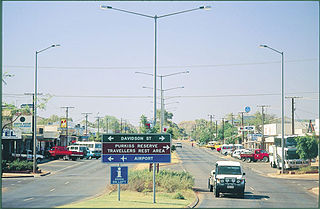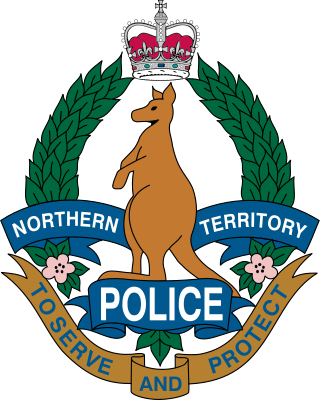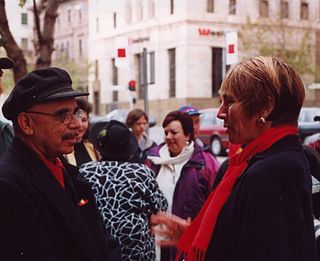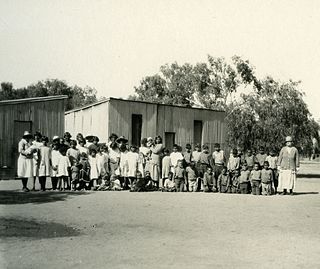Related Research Articles

The Northern Territory is an Australian internal territory in the central and central northern regions of Australia. The Northern Territory shares its borders with Western Australia to the west, South Australia to the south, and Queensland to the east. To the north, the territory looks out to the Timor Sea, the Arafura Sea and the Gulf of Carpentaria, including Western New Guinea and other islands of the Indonesian archipelago.

Tennant Creek is a town located in the Northern Territory of Australia. It is the seventh largest town in the Northern Territory, and is located on the Stuart Highway, just south of the intersection with the western terminus of the Barkly Highway. At the 2021 census, Tennant Creek had a population of 3,080 people, of which 55% (1,707) identified themselves as Indigenous.

The Northern Territory Police Force is the police body that has legal jurisdiction over the Northern Territory of Australia. This police service has 1,607 police members made up of 83 senior sergeants, 228 sergeants, 912 constables, 220 auxiliaries, and 64 Aboriginal Community Police Officers. The rest of the positions are members of commissioned rank and inoperative positions. It also has a civilian staff working across the NT Police, Fire and Emergency Services.

Harold Joseph Thomas, also known as Bundoo, is an Aboriginal Australian artist and former activist, known for designing and copyrighting the Australian Aboriginal flag. He claims to have designed the flag in 1971 as a symbol of the Aboriginal land rights movement, and in 1995 it was made an official "Flag of Australia". After this, his assertion of copyright over his design was upheld by the Federal Court, eventually transferring that copyright to the Commonwealth of Australia and making it freely available for public use in January 2022.

Charles Lydiard Aubrey Abbott was an Australian politician and public servant. He served as administrator of the Northern Territory from 1937 to 1946, a period encompassing the bombing of Darwin and other Japanese air raids on the territory during World War II. Originally a grazier from New South Wales, he was a Country Party politician prior to his time in the Northern Territory and served as Minister for Home Territories in the Bruce–Page government from 1928 to 1929. He was a member of the House of Representatives from 1925 to 1929 and 1931 to 1937, representing the seat of Gwydir.
Lorna "Nanna Nungala" Fejo was a Warumungu woman who worked in Indigenous health in the Northern Territory of Australia, including the development of a program called "Strong women, Strong Babies and Strong Culture". As a member of the Stolen Generations, having been removed from her family as a young child, she was named by Prime Minister Kevin Rudd, in his historic Apology to the Stolen Generations on 13 February 2008.
Robert James Randall, also known as Uncle Bob, was an Aboriginal Australian elder, singer and community leader. He was a member of the Stolen Generations and became an elder of the Yankunytjatjara people from Central Australia. He was the 1999 NAIDOC Person of the Year. He is known for his 1970 song, "My Brown Skin Baby ".
Contemporary Indigenous Australian art is the modern art work produced by Indigenous Australians, that is, Aboriginal Australians and Torres Strait Islander people. It is generally regarded as beginning in 1971 with a painting movement that started at Papunya, northwest of Alice Springs, Northern Territory, involving Aboriginal artists such as Clifford Possum Tjapaltjarri and Kaapa Tjampitjinpa, and facilitated by white Australian teacher and art worker Geoffrey Bardon. The movement spawned widespread interest across rural and remote Aboriginal Australia in creating art, while contemporary Indigenous art of a different nature also emerged in urban centres; together they have become central to Australian art. Indigenous art centres have fostered the emergence of the contemporary art movement, and as of 2010 were estimated to represent over 5000 artists, mostly in Australia's north and west.
Reuben Cooper is a former Australian rules footballer. He is notable for playing for the South Melbourne in the Victorian Football League.

Arltunga Historical Reserve, known also as Arnerre-ntyenge is a deserted gold rush town located in the Northern Territory of Australia in the locality of Hart about 110 kilometres (68 mi) east of Alice Springs. It is on the lands of the Eastern Arrernte people who are the Traditional Owners.

Hetty Perkins was an elder of the Eastern Arrernte people, an Aboriginal group from Central Australia. Several of her descendants have had prominent careers in various fields, both in the Northern Territory and in other states and territories.

The Bungalow was an institution for Aboriginal children established in 1914 in Alice Springs in the Northern Territory of Australia. It existed at several locations in Alice Springs, Jay Creek and the Alice Springs Telegraph Station.
Walter Smith also known as Walter Purula (Perrurle) or Wati Yuritja was a legendary Australian bushman from the Arltunga region in the Northern Territory of Australia. Wati Yuritja translates as man of the Water Dreaming).

Topsy Smith was an Arabana pioneer of Central Australia in the Northern Territory. She spent her life caring for Indigenous children at an institution known as The Bungalow in Alice Springs.
Brenda L. Croft is an Aboriginal Australian artist, curator, writer, and educator working across contemporary Indigenous and mainstream arts and cultural sectors. Croft was a founding member of the Boomalli Aboriginal Artists Cooperative in 1987.

Robert Stott was a constable and later police commissioner in the Northern Territory of Australia.
Woodgreen Station, also spelt Wood Green and also known as Atartinga, is a cattle station located in the Northern Territory of Australia, to the northeast of Alice Springs, extending approximately 2,215 km2 (855 sq mi). It was also known as (Mer) Athatheng by some of the Indigenous people in the area.
Philip Gudthaykudthay, also known as Pussycat, was an Aboriginal Australian artist. His work is held in many public galleries in Australia and internationally, including the British Museum.
Pine Creek Home also known as Pine Creek Boys Home was a government run home in Pine Creek in the Northern Territory which operated from 1931 to 1933 which perpetrated the Stolen Generations. The home was initially established to reduce overcrowding at the Myilly Point Home, just outside the Kahlin Compound, in Darwin. During this period it housed only boys and, when the home closed, they were primarily moved to The Bungalow in Alice Springs.
References
- 1 2 3 4 "Joseph Croft, b. 1926". National Portrait Gallery people. Retrieved 10 April 2024.
- 1 2 3 4 5 6 7 8 9 10 11 12 Croft, Brenda L., "Joseph (Joe) Croft (c. 1925–1996)", Australian Dictionary of Biography, Canberra: National Centre of Biography, Australian National University, retrieved 10 April 2024
- ↑ "Life Summary - Joseph (Joe) Croft - Indigenous Australia". ia.anu.edu.au. Retrieved 11 April 2024.
- ↑ "Myilly Point Home - Summary | Find & Connect". www.findandconnect.gov.au. Retrieved 11 April 2024.
- 1 2 3 Traynor, Stuart (2016), Alice Springs : from singing wire to iconic outback town, Wakefield Press, p. 309, ISBN 978-1-74305-449-9
- ↑ Find & Connect Web Resource Project, The University of Melbourne and Australian Catholic University. "Pine Creek Home - Organisation - Find & Connect - Northern Territory". www.findandconnect.gov.au. Retrieved 11 April 2024.
- ↑ "Biography - Alec Kruger - Indigenous Australia". ia.anu.edu.au. Retrieved 11 April 2024.
- ↑ Croft, Joe; Read, Peter, 1945- (1989), Joe Croft interviewed by Peter Read in the Peter Read collection of interviews conducted for his book entitled, Charles Perkins : a biography , retrieved 11 April 2024
{{citation}}: CS1 maint: multiple names: authors list (link) CS1 maint: numeric names: authors list (link) - ↑ Austin, Tony (1 October 2000), "Genocide and schooling in Capricornia: educating the Stolen Generation", History of education review, 29 (2), Australian and New Zealand History of Education Society: 51, ISSN 0819-8691
- ↑ "Half-caste for university". The Sydney Morning Herald . No. 33, 138. New South Wales, Australia. 10 March 1944. p. 4. Retrieved 11 April 2024– via National Library of Australia.
- ↑ "Varsity course for cleaver half-caste". The Worker (Brisbane) . Vol. 55, no. 2959. Queensland, Australia. 20 March 1944. p. 16. Retrieved 11 April 2024– via National Library of Australia.
- ↑ "Half-caste native will study at Brisbane university". [The Sun News-Pictorial]]. No. 6697. Victoria, Australia. 10 March 1944. p. 4. Retrieved 11 April 2024– via National Library of Australia.
- ↑ Croft, Joe (1989). "Oral history interviews in Alice Springs, Wattie Creek and Darwin, NT". AIATSIS Catalouge. Retrieved 11 April 2024.
- ↑ CROFT JOSEPH : Service Number - QX63365 : Date of birth - 08 Jan 1926 : Place of birth - NT : Place of enlistment - QLD : Next of Kin - KEELER MARJORY. 1940–1947.
- ↑ Croft, Brenda L. (12 May 2015). "Still in My Mind: An Exploration of Practice-led Experimental Research in Progress". Cultural Studies Review. 21 (1): 230–48. doi:10.5130/csr.v21i1.4433. ISSN 1837-8692.
- 1 2 3 "The many journeys of Joe Croft". The Canberra Times . Vol. 63, no. 19, 331. Australian Capital Territory, Australia. 9 September 1988. p. 2. Retrieved 11 April 2024– via National Library of Australia.
- 1 2 "The Joseph and Lindsay Croft memorial scholarship" (PDF). Australian National University. Retrieved 15 April 2024.
- ↑ "Joseph (Joe) Croft Indigenous Award". St John's College Foundation. 22 June 2017. Retrieved 11 April 2024.
- ↑ "Joe Croft Street, Bonner, ACT". Actmapi. Retrieved 15 April 2024.